Establishment of a basis for administrative use of PestSurf
Annex 11
11 Comparison of risk assessment data produced by spray drift assessments, FOCUS SW and PestSurf
11.1 Chemical characteristics of the compound
| Compound: | Terbutylazin |
| Dose: | 500 g ai./ha |
| Spraying time: | 15th May |
| Crop: | Maize |
Table 11.1. Overview of chemical properties of terbutylazin and the parameters used in the simulations.
Tabel 11.1. Oversigt over terbutylazin s kemiske egenskaber og parametrene brugt i simuleringerne.
| Chemical property | Condition | Recalculated values | |||
| Cas-no. | 5915-41-3 | ||||
| Molecular weight | 229.71 | ||||
| Form (acid, basic, neutral) | basic | ||||
| pKa | 2 | ||||
| Water solubility | 8.5 µg/l | ||||
| log Kow | at pH | KowA- | |||
| log Kow | 3.21 | at pH | KowAH | 3.21 | |
| log Kow | at pH | KowAH+ | |||
| Vapor pressure, Pa | 1.5 × 10-4 | 20°C | 270°C (Decomposition) | vapor pressure, Pa, 20°C | |
| Henry’s law constant | Calculated in Pestsurf | Recalculated value, dimensionless | |||
| Sorption properties in soil | |||||
| Freundlich exp | 0.9 | ||||
| Koc, l/kg | 251 | ||||
| DT50 in soil, days | 63.8 | ||||
| DT50water | 6.5 days | PestSurf input | |||
| DT50sedment | No degradation | ||||
| DT50water/sediment | 33 (220 g sed+ 550 ml water), 33 (220 g sed+ 550 ml water) | DT50, days | 57 | ||
| Sediment konc., µg/l | 425000 | ||||
| Hydrolysis | 73 | at pH 5 | (acid) | 9.90 × 10-4 | |
| 204.6 | at pH 7 | (neutral) | 279 | ||
| 194 | at pH 9 | (basic) | 8.32 × 10-5 | ||
| Photolysis | |||||
| quantum yield | Set to 0. DT50 = 172 d, practically 0 | ||||
| Spectrum | |||||
| Other | |||||
11.2 Concentration generated by spray
| Direct spray | FOCUS buffer zones | |||
| Ditch | Stream | Pond | ||
| µg l-1 | µg l-1 | µg l-1 | µg l-1 | |
| Terbutylazin | 166.7 | 3.558 | 2.589 | 1.247 |
11.3 Concentrations generated by FOCUS SW
11.3.1 D3 - Ditch
| Terbutylazin | Ditch, D3 | |||||||
| Water | Sediment | |||||||
| Date | PEC | Date | TWAEC | Date | PEC | Date | TWAEC | |
| µg l-1 | µg l-1 | µg kg-1 | µg kg-1 | |||||
| Global max | 14-maj-92 | 2.620 | 15-maj-92 | 0.864 | ||||
| 1 d | 15-maj-92 | 1.160 | 15-maj-92 | 1.968 | 16-maj-92 | 0.656 | 16-maj-92 | 0.826 |
| 2 d | 16-maj-92 | 0.154 | 16-maj-92 | 1.259 | 17-maj-92 | 0.487 | 16-maj-92 | 0.747 |
| 4 d | 18-maj-92 | 0.008 | 18-maj-92 | 0.651 | 19-maj-92 | 0.347 | 18-maj-92 | 0.608 |
| 7 d | 21-maj-92 | 0.002 | 21-maj-92 | 0.374 | 22-maj-92 | 0.261 | 21-maj-92 | 0.487 |
11.3.2 D4 – Pond
| Terbutylazin | Pond, D4 | |||||||
| Water | Sediment | |||||||
| Date | PEC | Date | TWAEC | Date | PEC | Date | TWAEC | |
| µg l-1 | µg l-1 | µg kg-1 | µg kg-1 | |||||
| Global max | 21-dec-85 | 0.903 | 07-jan-86 | 2.127 | ||||
| 1 d | 22-dec-85 | 0.897 | 22-dec-85 | 0.902 | 08-jan-86 | 2.126 | 08-jan-86 | 2.127 |
| 2 d | 23-dec-85 | 0.884 | 22-dec-85 | 0.9 | 09-jan-86 | 2.124 | 08-jan-86 | 2.127 |
| 4 d | 25-dec-85 | 0.849 | 23-dec-85 | 0.895 | 11-jan-86 | 2.116 | 09-jan-86 | 2.126 |
| 7 d | 28-dec-85 | 0.792 | 24-dec-85 | 0.887 | 14-jan-86 | 2.095 | 11-jan-86 | 2.124 |
11.3.3 D4 – Stream
| Terbutylazin | Stream, D4 | |||||||
| Water | Sediment | |||||||
| Date | PEC | Date | TWAEC | Date | PEC | Date | TWAEC | |
| µg l-1 | µg l-1 | µg kg-1 | µg kg-1 | |||||
| Global max | 30-maj-85 | 2.277 | 20-dec-85 | 1.857 | ||||
| 1 d | 31-maj-85 | 0.016 | 10-dec-85 | 1.273 | 21-dec-85 | 1.853 | 21-dec-85 | 1.855 |
| 2 d | 01-jun-85 | 0.015 | 08-dec-85 | 1.208 | 22-dec-85 | 1.836 | 22-dec-85 | 1.853 |
| 4 d | 03-jun-85 | 0.014 | 10-dec-85 | 1.174 | 24-dec-85 | 1.792 | 22-dec-85 | 1.851 |
| 7 d | 06-jun-85 | 0.013 | 11-dec-85 | 1.145 | 27-dec-85 | 1.722 | 23-dec-85 | 1.845 |
11.3.4 Conclusion – FOCUS SW
The highest concentration is generated in the ditch (D3). It is caused by wind drift and the concentration becomes 2.62 µg/l. The pond scenario shows the highest concentration in the sediment, 2.13 µg/l. For all scenarios, the concentrations are lower than what is generated by the simpler assessments.
11.4 PestSurf
11.4.1 Sandy Catchment, Stream
The distribution of concentrations was assessed in several steps. First, the maximum concentrations at each calculation point were listed, and the dates for the occurrence of the maximum were assessed. The points, for which the maximum value also represents a local maximum were selected for further analysis. The relevant values are listed in Table 11.2.
Table 11.2. Maximum concentrations (ng/l) of terbutylazin simulated for each calculation point in the sandy catchment.
Tabel 11.2. Maximumkoncentrationer (ng/l) af terbutylazin simuleret for hvert beregningspunkt i det sandede opland.
| TERBUTYLAZIN | Maximum | Max.Time | Local maxima |
| ODDERBAEK 0.00 | 519 | 15-05-1998 09:08 | |
| ODDERBAEK 56.00 | 560 | 15-05-1998 09:00 | |
| ODDERBAEK 112.00 | 695 | 15-05-1998 08:51 | |
| ODDERBAEK 192.00 | 1845 | 15-05-1998 08:33 | |
| ODDERBAEK 272.00 | 3155 | 15-05-1998 08:33 | |
| ODDERBAEK 278.00 | 3310 | 15-05-1998 08:33 | |
| ODDERBAEK 282.00 | 3410 | 15-05-1998 08:33 | |
| ODDERBAEK 298.50 | 3691 | 15-05-1998 08:33 | |
| ODDERBAEK 315.00 | 4006 | 15-05-1998 08:33 | |
| ODDERBAEK 317.50 | 4055 | 15-05-1998 08:33 | |
| ODDERBAEK 320.00 | 4099 | 15-05-1998 08:33 | |
| ODDERBAEK 410.00 | 5455 | 15-05-1998 08:33 | |
| ODDERBAEK 500.00 | 6063 | 15-05-1998 08:33 | |
| ODDERBAEK 513.00 | 6333 | 15-05-1998 08:33 | |
| ODDERBAEK 521.00 | 6526 | 15-05-1998 08:33 | |
| ODDERBAEK 622.00 | 7848 | 15-05-1998 08:33 | |
| ODDERBAEK 723.00 | 8840 | 15-05-1998 08:33 | |
| ODDERBAEK 733.00 | 9117 | 15-05-1998 08:33 | |
| ODDERBAEK 742.00 | 9304 | 15-05-1998 08:33 | |
| ODDERBAEK 789.50 | 9892 | 15-05-1998 08:33 | |
| ODDERBAEK 837.00 | 10449 | 15-05-1998 08:33 | |
| ODDERBAEK 848.00 | 10690 | 15-05-1998 08:33 | |
| ODDERBAEK 863.00 | 10994 | 15-05-1998 08:33 | |
| ODDERBAEK 956.00 | 12012 | 15-05-1998 08:33 | |
| ODDERBAEK 1049.00 | 12315 | 15-05-1998 08:33 | x |
| ODDERBAEK 1111.50 | 11944 | 15-05-1998 08:33 | |
| ODDERBAEK 1174.00 | 10827 | 16-05-2001 08:33 | |
| ODDERBAEK 1226.00 | 10157 | 16-05-2001 08:33 | |
| ODDERBAEK 1278.00 | 9860 | 16-05-2001 08:41 | |
| ODDERBAEK 1293.50 | 9739 | 16-05-2001 08:41 | |
| ODDERBAEK 1310.00 | 9509 | 16-05-2001 08:41 | |
| ODDERBAEK 1421.00 | 9176 | 16-05-2001 08:50 | |
| ODDERBAEK 1532.00 | 7978 | 16-05-2001 08:33 | |
| ODDERBAEK 1558.06 | 7062 | 15-05-1998 08:33 | |
| ODDERBAEK 1584.12 | 6595 | 15-05-1998 08:33 | |
| ODDERBAEK 1584.12 | 6595 | 15-05-1998 08:33 | |
| ODDERBAEK 1621.06 | 6597 | 15-05-1998 08:33 | |
| ODDERBAEK 1658.00 | 6733 | 15-05-1998 08:33 | |
| ODDERBAEK 1698.50 | 6989 | 15-05-1998 08:33 | |
| ODDERBAEK 1739.00 | 7188 | 15-05-1998 08:33 | |
| ODDERBAEK 1801.50 | 7233 | 16-05-2001 08:33 | x |
| ODDERBAEK 1864.00 | 5942 | 16-05-2005 08:33 | |
| ODDERBAEK 1977.00 | 4702 | 16-05-2000 09:45 | |
| ODDERBAEK 2090.00 | 4602 | 16-05-2000 09:54 | |
| ODDERBAEK 2098.00 | 4599 | 16-05-2000 09:54 | |
| ODDERBAEK 2105.00 | 4587 | 16-05-2000 09:54 | |
| ODDERBAEK 2131.00 | 4557 | 16-05-2000 09:54 | |
| ODDERBAEK 2157.00 | 4501 | 16-05-2000 10:00 | |
| ODDERBAEK 2168.00 | 4481 | 16-05-2000 10:00 | |
| ODDERBAEK 2179.00 | 4462 | 16-05-2000 10:00 | |
| ODDERBAEK 2268.50 | 4408 | 16-05-2000 10:00 | |
| ODDERBAEK 2358.00 | 4179 | 16-05-2000 10:00 | |
| ODDERBAEK 2363.50 | 4163 | 16-05-2000 10:00 | |
| ODDERBAEK 2372.00 | 4142 | 16-05-2000 10:00 | |
| ODDERBAEK 2427.00 | 4087 | 16-05-2000 10:00 | |
| ODDERBAEK 2482.00 | 3975 | 16-05-2004 10:00 | |
| ODDERBAEK 2609.00 | 3895 | 16-05-2004 10:00 | |
| ODDERBAEK 2736.00 | 3614 | 16-05-2001 11:00 | |
| ODDERBAEK 2831.00 | 3586 | 16-05-2001 11:00 | |
| ODDERBAEK 2926.00 | 3382 | 16-05-2001 11:00 | |
| ODDERBAEK 2958.50 | 3339 | 16-05-2001 11:00 | |
| ODDERBAEK 2991.00 | 3299 | 16-05-2000 11:00 | |
| ODDERBAEK 3029.50 | 3224 | 16-05-2000 11:00 | |
| ODDERBAEK 3068.00 | 3078 | 16-05-2004 11:00 | |
| ODDERBAEK 3131.00 | 2925 | 16-05-2004 11:00 | |
| ODDERBAEK 3194.00 | 2763 | 16-05-2004 11:00 | |
| ODDERBAEK 3250.50 | 2672 | 16-05-2004 11:00 | |
| ODDERBAEK 3307.00 | 2648 | 15-05-1998 12:00 | |
| ODDERBAEK 3315.00 | 2646 | 15-05-1998 12:00 | |
| ODDERBAEK 3323.00 | 2641 | 15-05-1998 12:00 | |
| ODDERBAEK 3355.50 | 2662 | 15-05-1998 08:33 | |
| ODDERBAEK 3388.00 | 2945 | 15-05-1998 08:33 | |
| ODDERBAEK 3438.50 | 3422 | 15-05-1998 08:33 | |
| ODDERBAEK 3489.00 | 3661 | 15-05-1998 08:33 | |
| ODDERBAEK 3499.50 | 3689 | 15-05-1998 08:33 | |
| ODDERBAEK 3510.00 | 3699 | 15-05-1998 08:33 | x |
| ODDERBAEK 3581.00 | 3694 | 15-05-1998 08:33 | |
| ODDERBAEK 3652.00 | 3382 | 15-05-1998 08:33 | |
| ODDERBAEK 3707.00 | 3185 | 15-05-1998 08:33 | |
| ODDERBAEK 3762.00 | 2983 | 15-05-1998 08:41 | |
| ODDERBAEK 3790.00 | 2677 | 15-05-1998 08:41 | |
| ODDERBAEK 3818.00 | 2171 | 15-05-1998 08:41 | |
| ODDERBAEK 3818.00 | 2171 | 15-05-1998 08:41 | |
| ODDERBAEK 3884.00 | 2121 | 15-05-1998 08:41 | |
| ODDERBAEK 3950.00 | 2001 | 15-05-1998 08:51 | |
| ODDERBAEK 3998.00 | 1927 | 15-05-1998 08:51 | |
| ODDERBAEK 4046.00 | 1786 | 15-05-1998 09:00 | |
| ODDERBAEK 4047.50 | 1787 | 15-05-1998 09:00 | |
| ODDERBAEK 4049.00 | 1787 | 15-05-1998 09:00 | |
| ODDERBAEK 4052.50 | 1787 | 15-05-1998 09:00 | |
| ODDERBAEK 4056.00 | 1786 | 15-05-1998 09:00 | |
| ODDERBAEK 4058.00 | 1786 | 15-05-1998 09:00 | |
| ODDERBAEK 4060.00 | 1786 | 15-05-1998 09:00 | |
| ODDERBAEK 4080.00 | 1786 | 15-05-1998 09:00 | |
| ODDERBAEK 4100.00 | 1783 | 15-05-1998 09:00 | |
| ODDERBAEK 4134.00 | 1779 | 15-05-1998 09:00 | |
| ODDERBAEK 4168.00 | 1776 | 15-05-1998 09:00 | |
| GISLUM_ENGE_AFLOEB 0.00 | 0 | 04-03-2005 00:00 | |
| GISLUM_ENGE_AFLOEB 50.00 | 1 | 04-03-2005 00:00 | |
| GISLUM_ENGE_AFLOEB 100.00 | 1 | 04-03-2005 00:00 | |
| GISLUM_ENGE_AFLOEB 150.00 | 1 | 03-03-2005 00:00 | |
| GISLUM_ENGE_AFLOEB 200.00 | 1 | 03-03-2005 00:00 | |
| GISLUM_ENGE_AFLOEB 250.00 | 1 | 03-03-2005 00:00 | |
| GISLUM_ENGE_AFLOEB 300.00 | 1 | 03-03-2005 00:00 | |
| GISLUM_ENGE_AFLOEB 340.00 | 1 | 03-03-2005 00:00 | |
| GISLUM_ENGE_AFLOEB 380.00 | 1 | 03-03-2005 00:00 | |
| GISLUM_ENGE_AFLOEB 430.00 | 1 | 03-03-2005 00:00 | |
| GISLUM_ENGE_AFLOEB 480.00 | 1 | 05-03-2005 00:00 | |
| GISLUM_ENGE_AFLOEB 530.00 | 1 | 05-03-2005 00:00 | |
| GISLUM_ENGE_AFLOEB 580.00 | 1 | 06-03-2005 00:00 | |
| GISLUM_ENGE_AFLOEB 630.00 | 1 | 06-03-2005 00:00 | |
| GISLUM_ENGE_AFLOEB 680.00 | 1 | 06-03-2005 00:00 | |
| GISLUM_ENGE_AFLOEB 730.00 | 1 | 06-03-2005 00:00 | |
| GISLUM_ENGE_AFLOEB 780.00 | 1 | 06-03-2005 00:00 | |
| GISLUM_ENGE_AFLOEB 830.00 | 1 | 06-03-2005 00:00 | |
| GISLUM_ENGE_AFLOEB 880.00 | 1 | 06-03-2005 00:00 | |
| GISLUM_ENGE_AFLOEB 915.00 | 1 | 06-03-2005 00:00 | |
| GISLUM_ENGE_AFLOEB 950.00 | 1 | 06-03-2005 00:00 | |
| GISLUM_ENGE_AFLOEB 985.00 | 1 | 06-03-2005 00:00 | |
| GISLUM_ENGE_AFLOEB 1020.00 | 1 | 06-03-2005 00:00 | |
| GISLUM_ENGE_AFLOEB 1045.00 | 1 | 06-03-2005 00:00 | |
| GISLUM_ENGE_AFLOEB 1070.00 | 1 | 06-03-2005 00:00 | |
| GISLUM_ENGE_AFLOEB 1110.00 | 1 | 06-03-2005 00:00 | |
| GISLUM_ENGE_AFLOEB 1150.00 | 1 | 06-03-2005 00:00 | |
| GISLUM_ENGE_AFLOEB 1190.00 | 1 | 06-03-2005 00:00 | |
| GISLUM_ENGE_AFLOEB 1230.00 | 2 | 15-05-1998 08:51 | |
| GISLUM_ENGE_AFLOEB 1271.00 | 6 | 15-05-1998 08:51 | |
| GISLUM_ENGE_AFLOEB 1312.00 | 17 | 15-05-1998 08:51 | |
| GISLUM_ENGE_AFLOEB 1422.00 | 307 | 15-05-1998 08:51 | |
| GISLUM_ENGE_AFLOEB 1532.00 | 2171 | 15-05-1998 08:41 | |
| TILLOEB 0.00 | 6302 | 15-05-1998 08:41 | |
| TILLOEB 20.16 | 6477 | 15-05-1998 08:41 | |
| TILLOEB 40.31 | 6595 | 15-05-1998 08:33 | x |
| Max | 12315 |
The pattern over time was dominated by drift for most calculation points, see Figure 11.1.
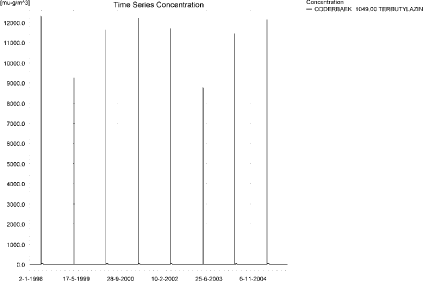
Figure 11.1. Concentration pattern over time for terbutylazin in the sandy Catchment.
Figur 11.1. Koncentrationsmønster som funktion af tid for terbutylazin i det sandede opland.
Each of the drift-events generated an almost identical pattern along the stream. Figure 11.2 to Figure 11.5 show the concentrations of terbutylazin in the sandy catchment.
The thin black line represents the concentration, while the thick black line shows the maximum concentrations obtained during the simulations. In addition, the outline of the stream is shown. In the middle of the catchment, the stream is protected by unsprayed areas.
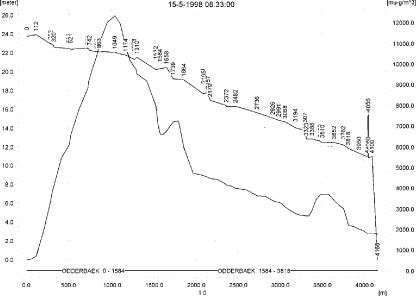
Figure 11.2. Concentrations of terbutylazin in the sandy catchment on 15. May 1998, 8.33.
Figur 11.2. Koncentrationer terbutylazin i det sandede opland den 15. maj 1998, 8.33.
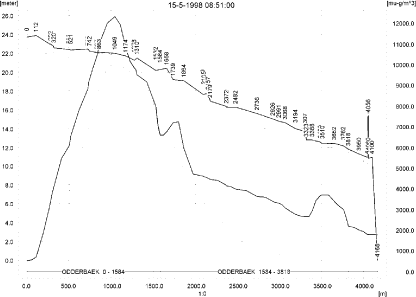
Figure 11.3. Concentrations of terbutylazin in the sandy catchment on 15. May 1998, 8.51.
Figur 11.3. Koncentrationer terbutylazin i det sandede opland den 15. maj 1998, 8.51.
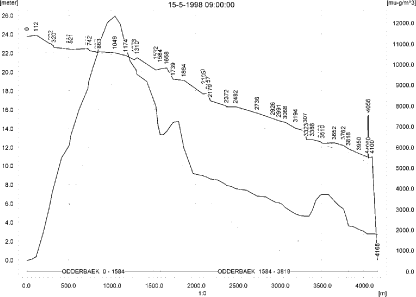
Figure 11.4. Concentrations of terbutylazin in the sandy catchment on 15. May 1998, 9.00.
Figur 11.4. Koncentrationer terbutylazin i det sandede opland den 15. maj 1998, 9.00.
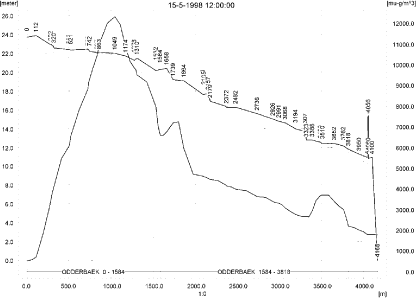
Figure 11.5. Concentrations of terbutylazin in the sandy catchment on 15. May 1998, 12.00.
Figur 11.5. Koncentrationer terbutylazin i det sandede opland den 15. maj 1998, 12.00.
In order to present the data in a similar fashion to the FOCUS SW-results, data were extracted and recalculated for the time series marked in Table 11.2. The global maxima and time weighted concentrations (up to 7 days) were extracted and are reported in Table 11.3. Note that the unit is ng/l.
The maximum amount of terbutylazin sorbed to macrophytes is shown in Figure 11.6. The concentrations are relatively low and have limited influence on the concentration in the water phase. The maximum value reached is 302 ng/l. The concentration of terbutylazin in porewater is shown in Figure 11.7. The maximum value is 0.772 ng/l, and a clear buildup is seen over time. The corresponding sorption to sediment in Figure 11.8. The maximum concentration equals 19.4 ng/kg.
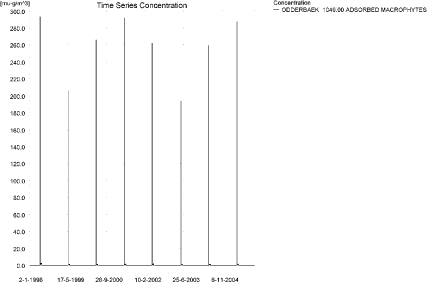
Figure 11.6. Concentration of terbutylazin sorbed to macrophytes in the sandy catchment. The maximum value reached is 302 ng/l 1421 m from the upstream end.
Figur 11.6. Typisk koncentration af terbutylazin sorberet på makrofytter i det sandede opland. Den maximalt opnåede værdi er 302 ng/l 1421 m fra den opstrøms ende.
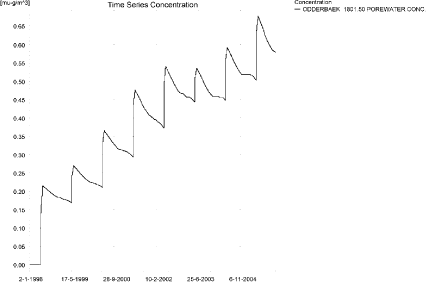
Figure 11.7. Pore water concentrations of terbutylazin in the sandy catchment.
Figur 11.7. Porevandskoncentrationer af terbutylazin i det sandede opland.
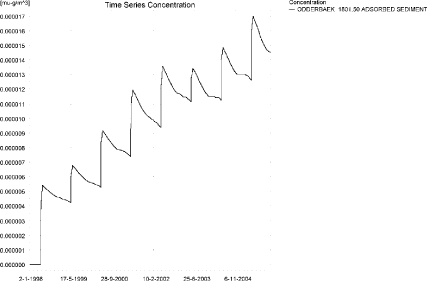
Figure 11.8. Sorption of terbutylazin to sediment in the sandy catchment. The concentration is in µg/g sediment and not µg/m³ as stated. The maximum value of 19.4 ng/kg is found 1421 m from the upstream end.
Figur 11.8. Sorption af terbutylazin til sediment i det sandede vandløb. Koncentrationen er i µg/g og ikke i µg/m³ som angivet. Maximumskoncentrationen, 19.4 ng/kg opnås 1421 m fra den opstrøms ende.
Table 11.3. Concentration (ng/l) of terbutylazin at selected points in the sandy stream.
Tabel 11.3. koncentration af terbutylazin, ng/l, på udvalgte lokaliteter i det sandede vandløb.
The global maximum value calculated by PestSurf for the sandy catchment in the water phase is 12.3 µg/l. This is considerably more than what is found in the D3-ditch scenario (2.62 µg/l). However, 112 m from the upstream end, the concentration is only 695 ng/l in the sandy catchment, and thus considerably lower than in the D3-ditch scenario. The macrophytes have a marginal influence on the water concentration. The sediment concentrations also differ considerably: 0.864 µg/kg compared to 0.019 µg/kg in PestSurf.
Figure 11.9 shows the output of the PestSurf Excel template. The template works with pre-defined data extraction points. The plot requires specification of a “lowest detection value” (ldc), which defines when a pesticide occurrence is defined as an event. The time series plot is identical to the time series shown earlier, and the graph in the upper right corner resembles the plots in Figure 11.2 but takes into account a longer period of time. A curve is generated when a downstream point reaches a concentration higher than the ldc. The programme then tracks the highest concentration for each calculation point in the stream within the last 24 hours. The plot in the lower right corner shows how many events have concentrations higher than a given value (ldc) for the selected monitoring points.
Table 11.4 shows part of the result sheet generated by the PestSurf Excel sheet based on the ldc-value. The selected table shows the point along the stream (of the pre-defined points) with the highest concentration. This value was, however, only 6.60 µg/l. Thus, the pre-defined points have not caught the highest concentration of the simulation, which was 12.3 µg/l.
Click here to see Figure 11.9.
Figure 11.9. Overview for terbutylazin in the sandy catchment generated by the PestSurf excel template. The max concentrations generated over the 24 hours are similar to the overviews in Figure 11.2 toFigure 11.5. Detection value was set to 1 ng/l.
Figur 11.9. Oversigt for terbutylazin i det sandede opland genereret med PestSurf-excel-skabelonen. Den maximale koncentration genereret over 24 timer svarer til oversigten i Figur 11.2 til Figur 11.5.. Detektionsgrænsen var sat til 1 ng/l.
Table 11.4. Part of the result sheet generated by the PestSurf Excel sheet. The selected table shows the point along the stream with the highest concentration recorded The lowest detection value is 1 ng/l, toxicity to fish, daphnies and algae are set to 10, 100 and 1000 ng/, respectively. The recorded peaks are shown in Figure 11.9.
Tabel 11.4. Uddrag af resultatpresentationen genereret af PestSurf-Excel-arket. Den udvalgte tabel viser det fordefinerede punkt langs med åen med højest koncentration. Detektionsgrænsen er sat til 1 ng/l mens toxicitetsværdierne for fisk, dafnier og alger er henholdsvis 10, 100 og 1000 ng/l. De tabellerede hændelser er vist i Figur 11.9.
11.4.2 Sandy catchment, pond
The concentration pattern is evaluated in the middle of the pond only, see Figure 11.10. The pond receives drift and a contribution from groundwater. The drift peaks are not visible. The baseflow contribution is dominating the picture. The maximum concentration is quite high, 2.99 µg/l.
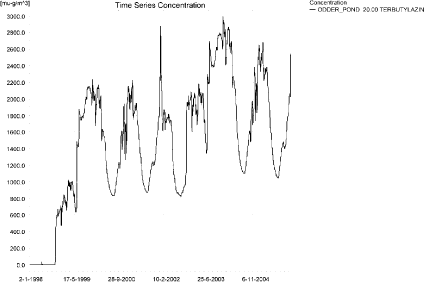
Figure 11.10. Concentrations of terbutylazin in the sandy pond.
Figur 11.10. Koncentration af terbutylazin i det sandede vandhul.
In Table 11.5, global maxima and time weighted concentrations (up to 7 days) were extracted.
Table 11.5. Maximum concentrations (ng/l) of terbutylazin generated by drift and baseflow for the sandy pond.
Tabel 11.5. maximumkoncentrationer af terbutylazin (ng/l) genereret for det sandede vandhul.
| Year | Terbutylazin | Actualmax | Time-weighted | Date of occurrence |
| 1998 | Global max | 712 | 14/12/1998 | |
| 1 hour(after max) | ||||
| 1 day after sp.in. | 710 | 711 | ||
| 2 days | 702 | 708 | ||
| 4 days | 695 | 706 | ||
| 7 days | 570 | 681 | ||
| 1999 | Global max | 2229 | 04/12/1999 | |
| 1 hour | ||||
| 1 day | 2219 | 2224 | ||
| 2 days | 2178 | 2208 | ||
| 4 days | 2166 | 2199 | ||
| 7 days | 2134 | 2179 | ||
| 2000 | Global max | 2164 | 10/02/2000 | |
| 1 hour | ||||
| 1 day | 2158 | 2161 | ||
| 2 days | 2130 | 2143 | ||
| 4 days | 2131 | 2140 | ||
| 7 days | 1989 | 2108 | ||
| 2001 | Global max | 2265 | 31/12/2001 | |
| 1 hour | ||||
| 1 day | 2216 | 2240 | ||
| 2 days | 2798 | 2472 | ||
| 4 days | 2811 | 2555 | ||
| 7 days | 2750 | 2665 | ||
| 2002 | Global max | 2875 | 06/01/2002 | |
| 1 hour | ||||
| 1 day | 2750 | 2813 | ||
| 2 days | 2673 | 2759 | ||
| 4 days | 2592 | 2728 | ||
| 7 days | 2354 | 2621 | ||
| 2003 | Global max | 2990 | 04/12/2003 | |
| 1 hour | ||||
| 1 day | 2984 | 2987 | ||
| 2 days | 2951 | 2976 | ||
| 4 days | 2942 | 2968 | ||
| 7 days | 2917 | 2953 | ||
| 2004 | Global max | 2868 | 10/02/2004 | |
| 1 hour | ||||
| 1 day | 2860 | 2864 | ||
| 2 days | 2835 | 2845 | ||
| 4 days | 2832 | 2842 | ||
| 7 days | 2681 | 2808 | ||
| 2005 | Global max | 2681 | 26/02/2005 | |
| 1 hour | ||||
| 1 day | 2671 | 2676 | ||
| 2 days | 2512 | 2625 | ||
| 4 days | 2388 | 2581 | ||
| 7 days | 2369 | 2488 | ||
| max values | ||||
| Global max | 2990 | |||
| 1 hour | 0 | 0 | ||
| 1 day | 2984 | 2987 | ||
| 2 days | 2951 | 2976 | ||
| 4 days | 2942 | 2968 | ||
| 7 days | 2917 | 2953 |
The sorption to macrophytes in the pond is shown in Figure 11.11. Although the value is relatively high, it is much lower than the concentration in the water phase. The concentration of terbutylazin in the porewater is steadily increasing throughout the simulation and reaches 811 ng/l, see Figure 11.12. The corresponding concentration of terbutylazin sorbed to sediment is shown in Figure 11.13. The concentration reaches 6.72 µg/kg.
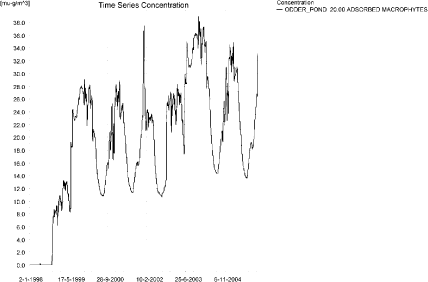
Figure 11.11. Sorption of terbutylazin to macrophytes in the sandy pond.
Figur 11.11. Sorption af terbutylazin til makrofytter i det sandede vandhul.
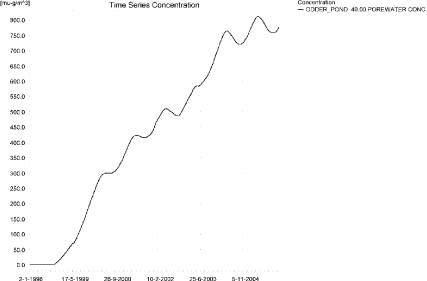
Figure 11.12. Pore water concentration of terbutylazin in the sandy pond.
Figur 11.12. Porevandskoncentration af terbutylazin i det sandede vandhul.
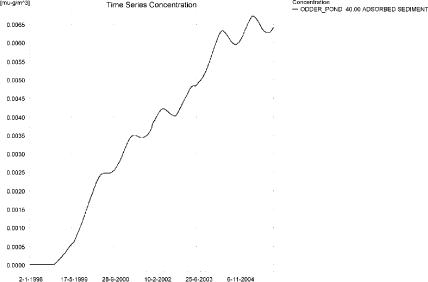
Figure 11.13. Sorption of terbutylazin to sediment in the sandy pond. The concentration is in µg/g sediment and not µg/m³ as stated.
Figur 11.13. Sorption af terbutylazin til sediment i det sandede vandhul. Koncentrationen er i µg/g og ikke i µg/m³ som angivet.
Compared to the FOCUS D3-ditch, the concentration in the PestSurf sandy pond is slightly higher, 2.99 µg/l compared to 2.62 µg/l. For once, the sediment concentration in PestSurf is considerably higher than in the D3-scenario, 6.72 µg/kg compared to 0.864 in FOCUS SW D3-ditch. The high value is due to a considerable buildup over time.
Figure 11.14 shows the output of the PestSurf Excel template. The template works with one pre-defined data extraction point for the pond (center of the pond). The plot requires specification of a “lowest detection value” (ldc) which defines when a pesticide occurrence is defined as an event. The time series plot is identical to the time series shown earlier. The plot in the right corner shows how many events have concentrations higher than a given toxicity value for the selected monitoring points.
Table 11.6 shows part of the result sheet generated by the PestSurf Excel sheet based on the ldc-value.
Click here to see Figure 11.14.
Figure 11.14. Overview for terbutylazin in the sandy pond generated by the PestSurf excel template. The time series shown is identical to the one in Figure 11.10. The lowest detection limit used for generation of the graph is 1500 ng/l.
Figur 11.14. Oversigt for terbutylazin i det sandede vandhul genereret med PestSurf-excel-skabelonen. Den viste tidsserie er mage til den i Figur 11.10. Detektionsgrænsen er sat til 1500 ng/l.
Table 11.6. Part of the result sheet generated by the PestSurf Excel sheet. The lowest detection value used for generation of the table is 1500 ng/l, toxicity to fish, daphnies and algae are set to 1501, 10000 and 100000 ng/, respectively. The recorded peaks are shown in Figure 11.14. EOF = End of file.
Tabel 11.6. Uddrag af resultatpresentationen genereret af PestSurf-Excel-arket. Grænseværdien anvendt til tabelgenerering er sat til 1500 ng/l mens toxicitetsværdierne for fisk, dafnier og alger er henholdsvis 1501, 10000 og 100000 ng/l. De tabellerede hændelser er vist i Figur 11.14. EOF = slutning af fil.
11.4.3 Sandy Loam catchment, Stream
The distribution of concentrations was assessed in several steps. First, the maximum concentrations at each calculation point were listed, and the dates for the occurrence of the maximum were assessed (Table 11.7). The points, for which the maximum value also represents a local maximum were selected for further analysis.
Table 11.7. Maximum concentrations (ng/l) of terbutylazin simulated for each calculation point in the sandy loam catchment.
Tabel 11.7. Maximumskoncentrationer (ng/l) af terbutylazin simuleret for hvert beregningspunkt i morænelersoplandet.
| TERBUTYLAZIN | Maximum | Max.Time | Local Maxima |
| ALBJERGBAEK 0.00 | 698 | 02-04-2000 00:00 | |
| ALBJERGBAEK 150.00 | 2033 | 16-09-1998 00:00 | x |
| ALBJERGBAEK 300.00 | 1339 | 16-09-1998 00:00 | |
| ALBJERGBAEK 450.00 | 1884 | 16-09-1998 00:00 | |
| ALBJERGBAEK 600.00 | 7916 | 14-05-2001 09:10 | x |
| ELHOLTBAEK 0.00 | 535 | 17-09-1998 00:00 | |
| ELHOLTBAEK 165.00 | 326 | 09-12-1999 00:00 | |
| ELHOLTBAEK 330.00 | 7191 | 14-05-2000 08:40 | x |
| FREDLIGBAEK 0.00 | 1067 | 17-09-1998 00:00 | |
| FREDLIGBAEK 100.00 | 1700 | 17-09-1998 00:00 | |
| FREDLIGBAEK 200.00 | 1805 | 17-09-1998 00:00 | |
| FREDLIGBAEK 300.00 | 1862 | 17-09-1998 00:00 | x |
| FREDLIGBAEK 400.00 | 1840 | 18-09-1998 00:00 | |
| FREDLIGBAEK 500.00 | 1722 | 18-09-1998 00:00 | |
| FREDLIGBAEK 600.00 | 2037 | 18-09-1998 00:00 | x |
| FREDLIGBAEK 667.50 | 1584 | 17-09-1998 00:00 | |
| FREDLIGBAEK 735.00 | 15574 | 14-05-1999 08:49 | x |
| GROFTEBAEK 0.00 | 1021 | 26-10-1998 00:00 | |
| GROFTEBAEK 155.00 | 1880 | 26-10-1998 00:00 | x |
| GROFTEBAEK 310.00 | 1621 | 26-10-1998 00:00 | |
| GROFTEBAEK 465.00 | 941 | 04-12-1998 00:00 | |
| GROFTEBAEK 620.00 | 15525 | 14-05-2000 08:40 | x |
| STENSBAEK 0.00 | 4017 | 05-09-2000 00:00 | |
| STENSBAEK 125.00 | 7727 | 07-09-2000 00:00 | x |
| STENSBAEK 250.00 | 5620 | 05-09-2000 00:00 | |
| STENSBAEK 412.50 | 7920 | 05-09-2000 00:00 | x |
| STENSBAEK 575.00 | 2783 | 07-09-2000 00:00 | |
| OVRELILLEBAEK 0.00 | 444 | 29-08-1998 00:00 | |
| OVRELILLEBAEK 125.00 | 15830 | 14-05-1998 08:30 | x |
| OVRELILLEBAEK 250.00 | 14694 | 14-05-2000 08:30 | |
| OVRELILLEBAEK 290.00 | 18742 | 14-05-2000 08:40 | x |
| OVRELILLEBAEK 330.00 | 7916 | 14-05-2001 09:10 | |
| OVRELILLEBAEK 330.00 | 7916 | 14-05-2001 09:10 | |
| OVRELILLEBAEK 352.50 | 10493 | 14-05-2001 09:30 | x |
| OVRELILLEBAEK 375.00 | 2783 | 07-09-2000 00:00 | |
| OVRELILLEBAEK 375.00 | 2783 | 07-09-2000 00:00 | |
| OVRELILLEBAEK 437.50 | 4489 | 14-05-2000 08:30 | |
| OVRELILLEBAEK 500.00 | 9161 | 14-05-2000 08:30 | |
| OVRELILLEBAEK 625.00 | 15546 | 14-05-2000 08:30 | x |
| OVRELILLEBAEK 750.00 | 9814 | 14-05-2000 08:30 | |
| OVRELILLEBAEK 855.00 | 13224 | 14-05-2000 08:30 | x |
| OVRELILLEBAEK 960.00 | 7191 | 14-05-2000 08:40 | |
| OVRELILLEBAEK 960.00 | 7191 | 14-05-2000 08:40 | |
| OVRELILLEBAEK 980.00 | 7579 | 14-05-2000 08:40 | x |
| OVRELILLEBAEK 1000.00 | 6307 | 14-05-1999 08:49 | |
| OVRELILLEBAEK 1062.50 | 6300 | 14-05-1999 08:49 | |
| OVRELILLEBAEK 1125.00 | 6208 | 14-05-2000 08:30 | |
| OVRELILLEBAEK 1187.50 | 7711 | 14-05-2000 08:30 | |
| OVRELILLEBAEK 1250.00 | 7877 | 14-05-2000 08:30 | |
| OVRELILLEBAEK 1425.00 | 10840 | 14-05-2000 08:30 | x |
| OVRELILLEBAEK 1600.00 | 8828 | 14-05-2000 08:30 | |
| OVRELILLEBAEK 1650.00 | 11352 | 14-05-2000 08:30 | x |
| OVRELILLEBAEK 1700.00 | 7770 | 14-05-1999 08:40 | |
| NEDRELILLEBAEK 0.00 | 7770 | 14-05-1999 08:40 | |
| NEDRELILLEBAEK 135.00 | 8022 | 14-05-2000 08:30 | |
| NEDRELILLEBAEK 270.00 | 11691 | 14-05-2000 08:30 | |
| NEDRELILLEBAEK 330.00 | 14891 | 14-05-2000 08:30 | |
| NEDRELILLEBAEK 390.00 | 16077 | 14-05-2000 08:30 | |
| NEDRELILLEBAEK 495.50 | 20847 | 14-05-2000 08:30 | x |
| NEDRELILLEBAEK 601.00 | 15574 | 14-05-1999 08:49 | |
| NEDRELILLEBAEK 601.00 | 15574 | 14-05-1999 08:49 | |
| NEDRELILLEBAEK 693.00 | 15433 | 14-05-1999 08:49 | |
| NEDRELILLEBAEK 785.00 | 15453 | 14-05-1999 09:00 | |
| NEDRELILLEBAEK 847.00 | 23982 | 14-05-2000 08:30 | x |
| NEDRELILLEBAEK 909.00 | 15525 | 14-05-2000 08:40 | |
| NEDRELILLEBAEK 909.00 | 15525 | 14-05-2000 08:40 | |
| NEDRELILLEBAEK 984.50 | 14383 | 14-05-2000 08:49 | |
| NEDRELILLEBAEK 1060.00 | 18021 | 14-05-2000 08:30 | |
| NEDRELILLEBAEK 1169.50 | 22591 | 14-05-2000 08:30 | |
| NEDRELILLEBAEK 1279.00 | 32148 | 14-05-2000 08:30 | x |
| NEDRELILLEBAEK 1409.50 | 20891 | 14-05-1999 08:49 | |
| NEDRELILLEBAEK 1540.00 | 14517 | 14-05-1999 09:40 | |
| Global max | 32148 |
For terbutylazin, drift is the most important contributor to maximum concentrations, but drainage events do play a role. Figure 11.15 shows the concentration pattern in Ovrelillebaek. The eight drift applications are clearly visible, but in addition, four peaks of 2-3 µg/l are found. The extreme rainfall event around 16-17. September 1998 and 1994 causes two of these peaks. The high concentrations observed in Ovrelillebaek during autumn 1996 and 2000 (around 7th September) are observed after a dry year close to the start of the drainage period. The flows are very small, in Lillebaek 10-12 cm, and in some of the tributaries, where the same peak is observed, only 4-5 cm (Steensbaek). Steensbaek is dry until around 1. September and Lillebaek until 15. August.
Figure 11.16 shows the pattern in the downstream end of the sandy loam catchment. In the downstream part of the system the picture is totally dominated by drift and contributions through the groundwater (reaching the stream system via drains). The concentrations build up over the 8 years simulated and becomes very high at the end of the summer of 2000 and 2001 (corresponding to a very dry year and a normal year, respectively). During these periods, the flow in the stream consists of base flow contributions through drain only. The drift contributions become relatively more important further downstream because the contributions accumulate.
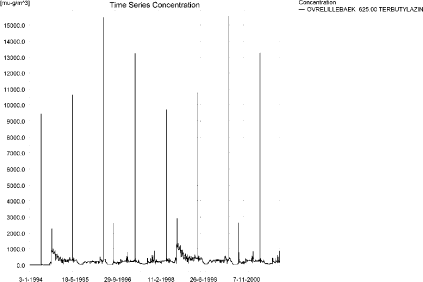
Figure 11.15. Concentration pattern for terbutylazin in the upstream end of the sandy loam catchment.
Figur 11.15. Koncentrationsmønster for terbutylazin i den øvre del af morænelersoplandet.
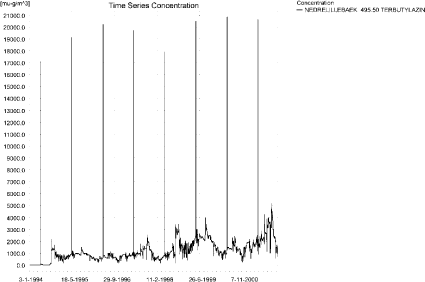
a)
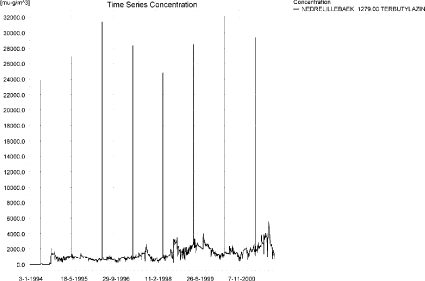
b)
Figure 11.16. Concentration pattern for terbutylazin in the lower end of the sandy loam catchment, at calculation point NedreLillebaek 495.5 and 1279.
Figur 11.16. Koncentrationsmønster for terbutylazin i den nedre del af morænelersoplandet, i bergningspunkterne Nedre Lillebæk 495.5 og 1279.
Longitudinal concentration profiles of the sandy loam catchment are shown in Figure 11.17 and Figure 11.18 for 18 September 1998 and 26 October 2001, respectively. Figure 11.19 shows the pattern for a drift contribution, just after spraying and 3.5 hours later. The thin black line represents the concentration, while the thick black line shows the maximum concentrations obtained during the simulations. In addition, the outline of the stream is shown.
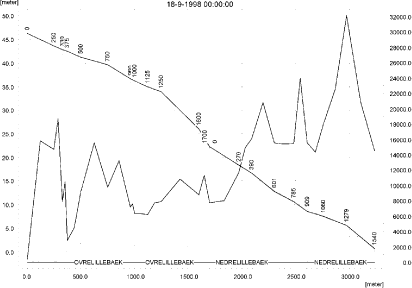
Figure 11.17. Concentrations in the sandy loam catchment on 18. September 1998. The concentrations are generated by the extreme rainfall this year.
Figur 11.17. Koncentrationer i morænelersoplandet den 18. september-1998. Koncentrationerne skyldes det ekstreme nedbørstilfælde dette år.
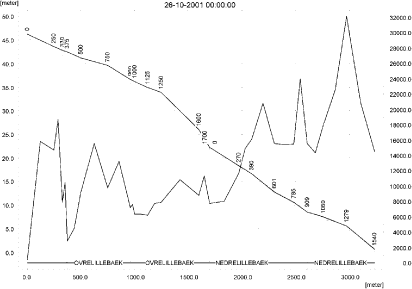
Figure 11.18. Concentrations in the sandy loam catchment on 26. October 2001. The concentrations are generated by baseflow contribution to the downstream end of the stream.
Figur 11.18. Koncentrationer i morænelersoplandet den 26. oktober-2001. Koncentrationerne er genereret af grundvandstilstrømning til den nedstrøms ende af vandløbet.
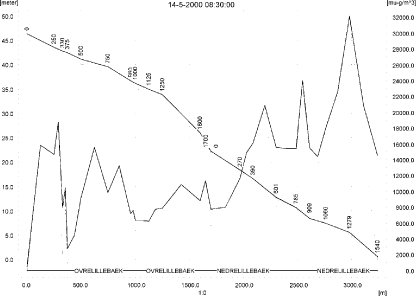
a)
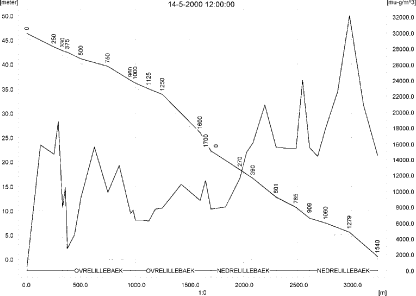
b)
Figure 11.19. Concentrations in the sandy loam catchment on 14. May 2000, at 8.30 (just after spraying) and at 12.00. The concentrations are generated by Drift contribution to the stream.
Figur 11.19. Koncentrationer i morænelersoplandet den 14.maj-2000, 08.30 (lige efter sprøjtning) og kl. 12.00. Koncentrationerne er genereret af vinddrift til vandløbet.
It is generally thought that the model overestimates the transport to groundwater, and, as a consequence of this, it overestimates the contribution through groundwater flow in the lower part of the catchment. The particularly high level of baseflow in the lower part of this catchment is due to occurrence of a sandy layer that transports solute horizontally through the catchment to the lower part of the stream. The high concentrations seen upstream just after a dry summer, however, are not considered an artefact.
To be able to extract comparable values to FOCUS SW, the global maxima and time weighted concentrations (up to 7 days) were extracted when these were meaningful. The results are recorded in Table 11.8.
Figure 11.20 and Figure 11.21 show the concentrations sorbed to macrophytes. The pattern follows the pattern of the water concentrations. In this case, the amount sorbed to macrophytes is significant and will influence the concentration of terbutylazin in the water phase. The maximum value of 3.18 µg/l is reached at the outlet of the catchment. The amount sorbed to macrophytes is in the order of 1/5-1/11 in the upstream part and up to half of the terbutylazin amount present above the sediment in the lower part of the catchment.
The concentration of terbutylazin in porewater in the sediment reached 169 ng/l in the upstream part and 902 ng/l in the lower part of Lillebaek. Figure 11.22 and Figure 11.24 show the pattern in the upstream and downstream end of the catchment. The concentrations increase over time, but in the upstream end, it reaches a maximum during spring of 1999. In the downstream end the concentration increases all through the simulation. The same pattern is visible for the concentration of terbutylazin adsorbed to sediment, see Figure 11.23 and Figure 11.25. The maximum concentration reached is 1.23 µg/kg in the upstream part and 6.56 µg/kg.
Compared to the FOCUS SW-stream-scenario for D4, the concentration level is higher, 32.1 µg/l compared to 2.28 µg/l. The highest values are found downstream where both a build up in groundwater concentrations and drift contributes. The buildup in groundwater is not represented by FOCUS SW. The same goes for the extreme event and the high concentrations seen in the upstream part after a dry summer.
125 m from the upstream end of the sandy loam catchment, the concentration reaches 15.8 µg/l. The corresponding water depth is about 4 cm. This difference explains the difference found between the two models.
For once the maximum sediment concentrations are of the same order of magnitude, 1.86 µg/kg calculated by FOCUS SW D4-stream and 6.56 µg/kg calculated by PestSurf.
Table 11.8. Instantaneous and time weighted concentrations (ng/l) of terbutylazin in the sandy loam catchment.
Tabel 11.8. Beregnedede og tidsvægtede koncentrationer (ng/l) af terbutylazin for udvalgte lokaliteter i morænelersoplandet.
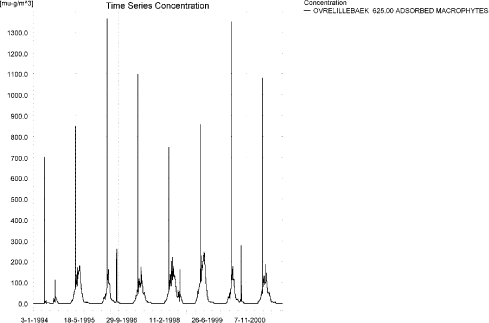
Figure 11.20. Concentration of terbutylazin on macrophytes 625 m from the upstream end. The pattern is representative of the upper part of the sandy loam catchment.
Figur 11.20. Koncentration af terbutylazin på makrofytter 625 m fra den opstrøms ende af morænelersoplandet. Mønsteret er repræsentativt for den øvre del af oplandet.
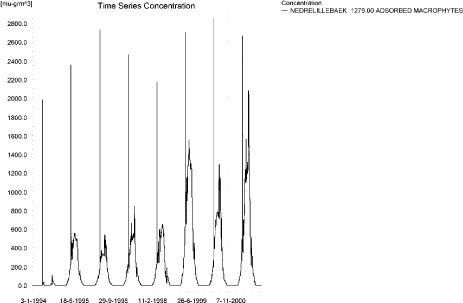
Figure 11.21. Concentration of terbutylazinon macrophytes at the lower part of the stream. The pattern is representative of the lower part of the sandy loam catchment.
Figur 11.21. Koncentration af terbutylazin på makrofytter i den nedstrøms ende af morænelersoplandet. Mønsteret er repræsentativt for den øvre del af oplandet.
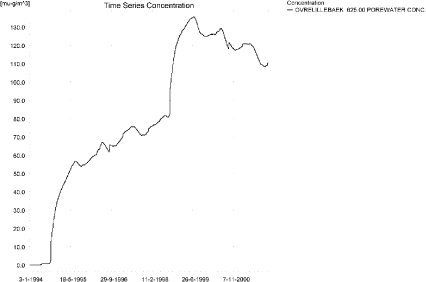
Figure 11.22. Example of porewater concentration of terbutylazin at the upstream part of the sandy loam catchment.
Figur 11.22. Eksempel på porevandskoncentration af terbutylazin i den opstrøms ende af morænelersoplandet.
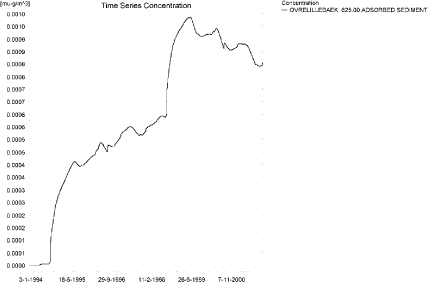
Figure 11.23. Example of sorption of terbutylazin on sediment in the upstream part of the sandy loam catchment. The concentration is in µg/g sediment and not µg/m³ as stated.
Figur 11.23. Eksempel på sorption af terbutylazin til sediment i den opstrøms del af morænelersoplandet. Koncentrationen er i µg/g sediment og ikke µg/m³ som angivet.
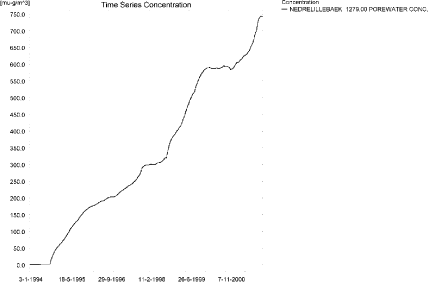
Figure 11.24. Pore water concentration of terbutylazin in the lower end of the sandy loam catchment. The maximum value reached in the lower end of the catchment is 902 ng/l.
Figur 11.24. Porevandskoncentration af terbutylazin i den nedstrøms ende af morænelersoplandet. Den maximale værdi opnået i den nedre del af oplandet er 902 ng/l.
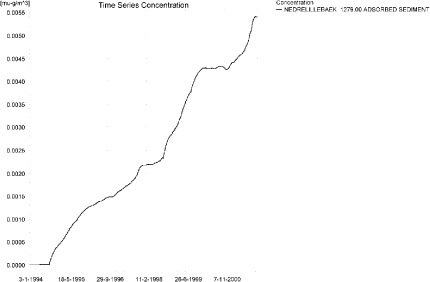
Figure 11.25. Sorption of terbutylazin on sediment in downstream end of the the sandy loam catchment. The concentration is in µg/g sediment and not µg/m³ as stated. The maximum value reached in the lower end is 6.56 µg/kg.
Figur 11.25. Sorption af terbutylazin til sediment i den nedstrøms del af morænelersoplandet. Koncentrationen er i µg/g sediment og ikke µg/m³ som angivet. Den maximalt opnåede værdi i den nedre ende er 6.56 µg/kg.
Figure 11.26 to Figure 11.28, Table 11.9 and Table 11.10 show the results as generated by the PestSurf templates. The maximum value generated by the templates for the upper part of the stream is 11.4 µg/l, and for the lower part, 32.1 µg/l. The maximum value generated in the upstream part of the catchment is 15.8 µg/l while the maximum in the spreadsheet and in the main stream is 32.1 µg/l. The template therefore did not catch the maximum concentration in the upstream end of the catchment, but it did catch the maximum value in the lower part of the catchment.
Click here to see Figure 11.26.
Figure 11.26. Overview for terbutylazin in the sandy loam catchment generated by the PestSurf excel template for the upstream part of the catchment. The detection value was set to 100 ng/l.
Figur 11.26. Oversigt for terbutylazin genereret med PestSurf-excel-skabelonen for den opstrøms del af morænelersoplandet. Detektionsgrænsen var sat til 100 ng/l.
Click here to see Figure 11.27.
Figure 11.27. Overview for terbutylazin in the sandy loam catchment generated by the PestSurf excel template for the upstream part of the catchment. The detection value for the graph to the lower right was set to 1000 ng/l. The figure to the lower right differs from Figure 11.26.
Figur 11.27. Oversigt for terbutylazin genereret med PestSurf-excel-skabelonen for den opstrøms del af morænelersoplandet. Detektionsgrænsen for grafen nederst til højre er sat til var sat til 1000 ng/l. Figuren nederst til højre er forskellig fra figur Figur 11.26.
Click here to see Figure 11.28.
Figure 11.28. Overview for terbutylazin in the sandy loam catchment generated by the PestSurf excel template for the downstream part of the catchment. The detection value was set to 1000 ng/l.
Figur 11.28. Oversigt for terbutylazin genereret med PestSurf-excel-skabelonen for den nedstrøms del af morænelersoplandet. Detektionsgrænsen var sat til 1000 ng/l.
Table 11.9. Part of the result sheet generated by the PestSurf Excel sheet for the upstream part of the sandy loam catchment. The lowest detection value for table generation is 100 ng/l, toxicity to fish, daphnies and algae are set to 1000, 10000 and 100000 ng/, respectively. The recorded peaks are shown in Figure 11.26.
Tabel 11.9. Uddrag af resultatpresentationen genereret af PestSurf-Excel-arket for den opstrøms del af morænelersoplandet. Detektionsgrænsen for tabelgenerering er sat til 100 ng/l. Toxicitetsværdierne for fisk, dafnier og alger er henholdsvis 1000, 10000 og 100000 ng/l. Hændelserne er vist i Figur 11.26.
Table 11.10. Part of the result sheet generated by the PestSurf Excel sheet for the downstream part of the sandy loam catchment. The lowest detection value is 1000 ng/l, toxicity to fish, daphnies and algae are set to 1001, 10000 and 100000 ng/, respectively. The recorded peaks are shown in Figure 11.28.
Tabel 11.10. Uddrag af resultatpresentationen genereret af PestSurf-Excel-arket for den nedstrøms del af morænelersoplandet. Detektionsgrænsen for tabelgenerering er sat til 1000 ng/l. Toxicitetsværdierne for fisk, dafnier og alger er henholdsvis 1001, 10000 og 100000 ng/l. Hændelserne er vist i Figur 11.28.
Click here to see Table 11.10.
11.4.4 Sandy loam catchment, pond
The concentration pattern is evaluated in the middle of the pond only, see Figure 11.29. The pond receives contributions through drift, in good correspondence with the fact that it is situated in the upper part of the sandy loam catchment. However, some contribution with drain flow appears to influence the concentration too. The maximum concentration is, 1.194 µg/l, and the highest concentrations are reached in dry and normal years.
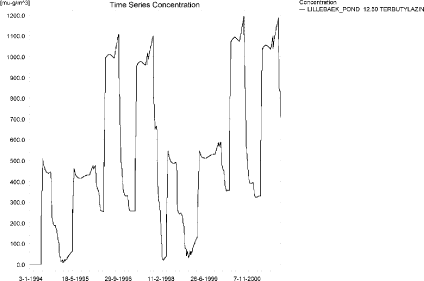
Figure 11.29. Concentrations of terbutylazin for the sandy loam pond.
Figur 11.29. Koncentration af terbutylazin i morænelersvandhullet.
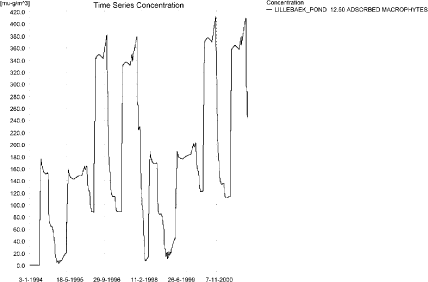
Figure 11.30. Terbutylazin sorbed to the macrophytes in the sandy loam pond.
Figur 11.30. Terbutylazin sorberet til makrofytter i morænelersvandhullet.
Figure 11.30 shows that the macrophytes participate in the regulation of the concentrations in the pond. The concentrations reach about a third of the level of the concentration in the water phase.
The pore water concentration is shown in Figure 11.31. It reaches 84 ng/l and seems to continue to increase. The concentration of terbutylazin in the sediment is shown in Figure 11.32. It reaches 0.694 µg/kg in the simulation period.
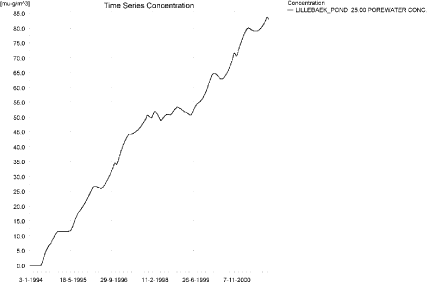
Figure 11.31. Pore water concentration of terbutylazin in the sandy loam pond.
Figur 11.31. Porevandskoncentration af terbutylazin i morænelersvandhullet.
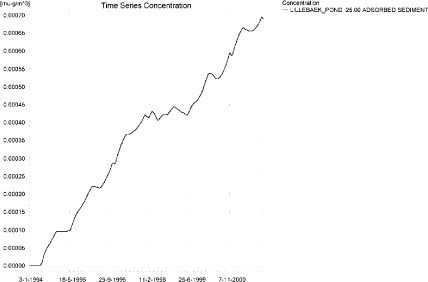
Figure 11.32. Terbutylazin sorbed to sediment in the sandy loam pond. The concentration is in µg/g sediment and not µg/m³ as stated.
Figur 11.32. Terbutylazin sorberet til sediment i morænelersvandhullet. Koncentrationen er i µg/g sediment og ikke µg/m³ som angivet.
In Table 11.11, global maxima and time weighted concentrations (up to 7 days) were extracted.
Table 11.11. Actual and time weighted concentrations (ng/l) of terbutylazin in the sandy loam pond.
Tabel 11.11. Beregnede og tidsvægtede koncentrationer (ng/l) af terbutylazin i morænelersvandhullet.
| Year | Terbutylazin | Actual | Time-weighted | Date |
| 1994 | global max | 511 | 05-06-1994 | |
| 1 hour(after max) | 510 | 511 | ||
| 1 day after sp.in. | 506 | 508 | ||
| 3 days | 500 | 504 | ||
| 4 days | 497 | 503 | ||
| 7 days | 490 | 499 | ||
| 1995 | Global max | 462 | 05-06-1995 | |
| 1 hour | 461 | 462 | ||
| 1 day | 458 | 460 | ||
| 2 days | 455 | 457 | ||
| 4 days | 453 | 457 | ||
| 7 days | 448 | 454 | ||
| 1996 | global max | 1106 | 04-11-1996 | |
| 1 hour | ||||
| 1 day | 1101 | 1104 | ||
| 2 days | 973 | 1059 | ||
| 4 days | 939 | 1033 | ||
| 7 days | 892 | 981 | ||
| 1997 | global max | 1098 | 12-12-1997 | |
| 1 hour | ||||
| 1 day | 1021 | 1060 | ||
| 2 days | 840 | 966 | ||
| 4 days | 804 | 930 | ||
| 7 days | 781 | 871 | ||
| 1998 | global max | 665 | 16-01-1998 | |
| 1 hour | ||||
| 1 day | 664 | 665 | ||
| 2 days | 662 | 663 | ||
| 4 days | 662 | 663 | ||
| 7 days | 652 | 661 | ||
| 1999 | global max | 548 | 04-06-1999 | |
| 1 hour | 547 | 548 | ||
| 1 day | 544 | 546 | ||
| 2 days | 541 | 544 | ||
| 4 days | 540 | 543 | ||
| 7 days | 536 | 541 | ||
| 2000 | global max | 1194 | 03-11-2000 | |
| 1 hour | ||||
| 1 day | 1189 | 1191 | ||
| 2 days | 1051 | 1143 | ||
| 4 days | 1014 | 1116 | ||
| 7 days | 965 | 1060 | ||
| 2001 | global max | 1188 | 11-12-2001 | |
| 1 hour | ||||
| 1 day | 1104 | 1146 | ||
| 2 days | 910 | 1045 | ||
| 4 days | 870 | 1006 | ||
| 7 days | 846 | 942 | ||
| max values | ||||
| global max | 1194 | |||
| 1 hour | 548 | |||
| 1 day | 1189 | 1191 | ||
| 2 days | 1051 | 1143 | ||
| 4 days | 1014 | 1116 | ||
| 7 days | 965 | 1060 |
The FOCUS SW D4-pond-scenario and the PestSurf sandy loam pond generates comparable concentration levels. D4 generates a concentration of 0.903 µg/l while PestSurf reaches 1.19 µg/l. The concentration difference is less than what is the case when the main source of pesticide to the pond is drift.
However, the concentration in sediment is 1.857 µg/kg in FOCUS and only 0.694 µg/kg in the PestSurf simulation.
Figure 11.33 and Table 11.12 show output from the PestSurf template, with a time series identical to Figure 11.29.
Click here to see Figure 11.33.
Figure 11.33. Overview for terbutylazin in the sandy loam pond generated by the PestSurf excel template. The time series shown is identical to the one in Figure 11.29. The plot is generated with a lowest detection value of 400 ng/l.
Figur 11.33. Oversigt for terbutylazin i morænelersvandhullet genereret med PestSurf-excel-skabelonen. Den viste tidsserie er mage til den i Figur 11.29. Detektionsgrænsen er sat til 400 ng/l.
Table 11.12. Part of the result sheet generated by the PestSurf Excel sheet. The lowest detection value is 400 ng/l, toxicity to fish, daphnies and algae are set to 800, 1200 and 10000 ng/, respectively. The recorded peaks are shown in Figure 11.33.
Tabel 11.12. Uddrag af resultatpresentationen genereret af PestSurf-Excel-arket. Detektionsgrænsen er sat til 400 ng/l. Toxicitetsværdierne for fisk, dafnier og alger er henholdsvis 800, 1200 og 10000 ng/l. De tabellerede hændelser er vist i Figur 11.33.
Click here to see Table 11.12.
Table 11.13. Summary of simulation results for terbutylazin.
Tabel 11.13. Opsummerede resultater for terbutylazin.
Click here to see Table 11.13.
11.5 Summary of simulations
The maximum actual concentrations for all simulations are recorded in Table 11.13.
The maximum concentration reached for the D3-ditch is lower than the concentration reached for the sandy pond and for the sandy stream. The concentration reached in the D3-ditch and the sandy stream is caused by drift, while the concentration reached in the pond is caused by shallow groundwater. The high concentration reached in the sandy stream is caused by spraying of the total agricultural area within 30 minutes. However, 112 m from the upstream end, the concentration is only 695 ng/l in the sandy catchment, and thus considerably lower than in the D3-ditch scenario (2.62 µg/l). The difference is, however, due to a combination of a bufferzone of 20 m width and a water depth of 8-9 cm.
The concentration reached in D4-pond and the sandy loam pond are of the same level of magnitude. Both concentrations are reached during the drainage season and are caused by drainage contributions to the pond.
The concentrations reached in the D4 stream and the sandy loam stream are considerably different. PestSurf generates a maximum concentration of 32.1 µg/l compared to 2.28 µg/l generated by FOCUS SW. The highest values in PestSurf are found downstream where both a build up in groundwater concentrations and drift contributes. The buildup in groundwater is not represented by FOCUS SW. The same goes for the extreme rainfall event and the high concentrations seen in the upstream part after a dry summer. These events generate high- but not the highest concentrations. 125 m from the upstream end of the sandy loam catchment, the concentration reaches 15.8 µg/l. The corresponding water depth is about 4 cm. This difference explains the difference found between the two models.
With respect to the sediment concentrations, the concentration reached in the sandy pond is considerably higher than the concentration reached in the D3-ditch (6.72 compared to 0.864 µg/kg). Also for the sandy loam stream, the sediment concentration is much higher (6.56 µg/l) than the concentration reached in the D4-stream (1.86 µg/kg). However, for the sandy loam pond, the sediment concentration is lower (0.694 µg/kg) than for the D4-pond (2.13 µg/kg). If the maximum concentration is evaluated on the stretch between 500-1700 m, the maximum concentration is 15.5 µg/l.
The models differ substantially due to presence or absence of macrophytes. Particularly for the sandy loam pond and stream, the concentrations in the water phase are influenced by the presence of macrophytes.
Version 1.0 December 2006, © Danish Environmental Protection Agency